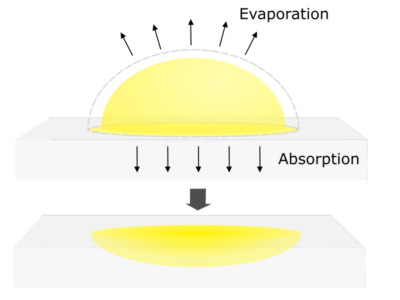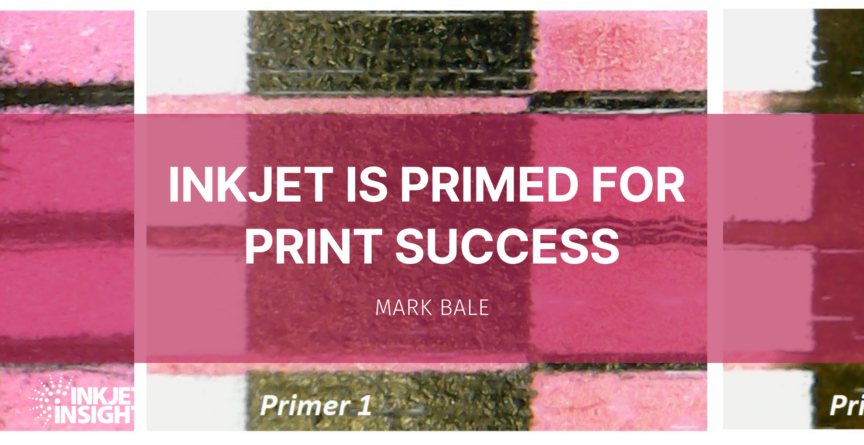Inkjet is being used in a never-ending number of manufacturing processes from paper to glass/ceramics, and plastic, metal and wood. In my last chemistry related article back in March, I talked about the challenges in making post-coatings suitable for inkjet in order to improve the suitability for different uses. I mentioned a bit about hybrid print process including primers, as we also have included in a number of our previous articles, most notable those on packaging. So far though, I haven’t really tried to look at the chemistry in much detail. Spurred on by the recent sponsored Understanding Priming and Post-Coating for Inkjet – Inkjet Insight webinar given by Mary Schilling, the team thought it was about time that Insight’s resident ink nerd had a go at explaining how primers work.
Essentially, priming is all about asserting control over the ink and trying to limit the disadvantages that result from low viscosity inkjet inks. This means the inks pretty much like to do what they please, especially for surface structures with fibers or other inhomogeneity (non-uniform) exists.
As a result, primers are developed for each application type and it is often also critical to getting the right application performance, especially adhesion. The briefest of patents reviews shows that the use of coatings for control of inkjet dots for image quality can be traced back to the earliest uses of inkjet. A formulation as early as 1986, that is a pre-deposited jetting method (US4599627). Rather than trawl the history books however, we are going have a quick look at some contemporary examples with a bit of a focus on water-based inks using pigment as colorants.
As discussed in one of my first posts for Insight back in 2018, once a water-based droplet impacts surface it can either absorb, wet or evaporate. As we also explained, formulating the ink appropriately is all about getting the right balance between those processes. Depending on how much ink there is and how quickly it is being deposited, versus how much time is needed before the paper is touched again on the front face. Of course, to keep things reliable we also think about the behavior in the print head. It is tricky balancing act and primers are a key tool to make things a little easier.

Paper & Fibres
Still the topic of interest to most Insight subscribers is paper, since it easily represents the largest fraction of printed substrate because of use from home-office, through transactional to full-on production. As a substrate, paper represents a specific challenge because of the combination of the fibrous nature substrate and chemistry variations arising from materials added for “hold-out” of traditional printing inks.
The most common approaches in paper priming are utilizing acidic or cationic material in the primer in order to force the anionic or alkaline pigment to “crash” when the two materials interact. The main effect is to improve the optical density of the print, since the pigment is no longer dragged away into the paper but instead kept closer to the surface. In patents the primers are often called “aggregating” liquids because this describes a little better their intended role.
In most cases the primer can be relatively thin and still work well since the paper still does most the job of absorbing the water content, even if temporarily before immediately being dried again. In such cases, it becomes possible to apply the primer by inkjet means as long as the head can tolerate the required chemistry pH. As was raised in previously mentioned webinar, the fact that primers have this acidic functionality means that they are also potentially more corrosive than typical inks and appropriate steps have to be taken to avoid issues, even when the deposition is by analog means (e.g. roller coat or flexo).
The cationic materials are often metal salts, which were initially implemented to react with dyes that came before pigments. In some more recent implementations, the cationic materials are polymeric in nature, which gives some advantages to tuning the performance as well as potentially presenting a better health & safety profile compared to simply adding an acid.
It is not always straightforward in predicting performance and often a lot of trial and error is required. The microscope photos below give an example of the extremes in droplet behavior that can be obtained by materials that block the absorption of the paper too severely, thus leaving the ink wet too long prior to reaching the drier. The prints are wet-on-wet and the centre lines are where both black and magenta have been printed, whilst the top/bottom lines are knock-out features.

Non-Absorbing Substrates
When there is no absorption, we must deal with all the ink components with the primer. Therefore, the primers need to include something more substantial to “suck up” some of the ink carrier (water) before the drops have a chance to spread. These primers tend to be known as sizing primers and a common material used is colloidal silica, which can be made to have a very high porosity.
Photo paper is the best-known example of this type of approach, where the ability to print many passes at higher dpi is made possible by a high level of porosity within the filler materials (often silica) with some similar chemistry to that discussed above to promote the colorant to keep to the surface. In the photos below we can see the clear difference in dot size and shape between a print made on a paper-based substrate and an identical print made on a generic-branded photo paper. These single-pass prints show off-the-shelf photo paper can work to control print quality, but of course it is an expensive substrate and dot gain is so small that is it quite unforgiving of mechanical inaccuracy, such as that introduced by some minor variation in head rotation in the right-hand-side image. This highlights an important aspect of primers: as well as imply improve optical density, they should carefully balance the ink spread to promote the best possible print quality despite variations in the system. The print on films shows a better balance of dot gain.

Industrial Markets
For different application and markets, the optimum chemistry & specific film thickness is going to be application dependent, and some pairing of the ink and primer can be beneficial. In label printing, UV-curable inks can benefit from UV primers to achieve the most resilient outdoor weathering resistance, for example. In printing of leather water-based coatings make more sense prior to UV printing since it forms a more natural bridging layer between two very different materials. For glass a primer based on organo-silane chemistry is more common since it allows for a chemical bridge between the silicon atoms of the substrate and organic functionality of UV or solvent inks.
For packaging, a company in Europe makes water-based sizing primers so that printing onto plastic materials can be done using pigment water-based inks, such as with Memjet heads. The primer can promote wash resistance that is difficult to obtain with the ink by itself. This presents an interesting option in a market dominated by UV curing applications, which usually results in slightly more complex design.
The fast-growing textile market is another fine example of where primers have proven invaluable to the performance of the inkjet pigment inks, which is a topic we discussed Is Pigment the Ink for Textiles? – Inkjet Insight post. In this specific application coatings also comes into play, by introducing function such as anti-viral properties or hydrophobicity and some of these materials are now being deposited by inkjet methods.
Summary
The combination of possibilities created by combining chemistry for print quality optimisation and/or function are almost endless, but hopefully I’ve given you some introductory idea of the things that make a difference and glimpse into the type of materials often used. As always, please comment or get in touch if you have any comment or questions.


Comments
Mark,
Good overview of the technology and some of the challenges.
I tend to refer to the silica based layers as inkjet coatings and reserve the term primers for the fluids that can easily be applied inline and are designed, as you stated, to “crash” the pigments. Papers/substrates with inkjet coatings tend to be quite pricey since they have a fairly thick layer of inkjet coating on them. Depending on the application, it can easily be 20gsm or more. A primer is usually in the single digits.
Gianluigi
Thanks for the comment Gianluigi. I agree language can vary. For me, “coating” might typically be applied at source of manufacture (e.g. of a paper, especially). Primers are usually deposited in-line and even sometimes deliberately wet-on-wet. I don’t use the deposited weight/volume (e. g. gsm) to determine the terminology “primer” . The first flexo pre-coat I worked with for corrugated needed a 30gsm anilox to make much impact on an uncoated liner but since it was deposited in-situ we still called it a “primer” . This was regardless of whether or not it contained specific materials for a given function (such as silica). Regards, Mark